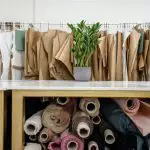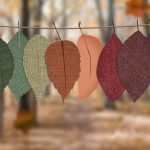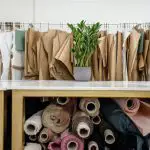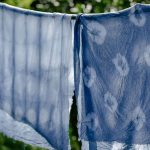When you explore the creation of damask fabric, you'll find a fascinating blend of history and technique that shapes its luxurious appeal. You might be surprised to learn that this intricate textile originates from Damascus and is crafted using both natural and synthetic fibers. The magic really happens in the weaving process, where Jacquard technology allows for stunning patterns to emerge. But what steps follow this initial weaving, and how do they influence the final product? Understanding this could change your perspective on how you view and choose fabrics.
Table of Contents
History of Damask Fabric
Damask fabric, known for its intricate patterns and luxurious feel, has roots that trace back to ancient civilizations, particularly in the Middle East and Asia. You mightn't realize that the name 'damask' comes from the city of Damascus, where this fabric was first produced. The rich history of damask dates back to the 12th century, when skilled artisans began weaving complex designs using silk and other fibers. These artisans were masters of their craft, creating fabrics that weren't only beautiful but also functional.
As you explore the history of damask, you'll find that its popularity spread throughout Europe during the Middle Ages. Nobles and royalty embraced this exquisite fabric for clothing and home decor, showcasing it as a symbol of wealth and status. By the Renaissance, damask had become a staple in the textile industry, with innovations in weaving techniques enhancing its appeal.
Today, you can still see the influence of this storied past in modern designs. Whether it's used in curtains, upholstery, or table linens, damask fabric continues to evoke a sense of elegance and history that captivates people across cultures and generations.
Types of Fibers Used
When it comes to Damask fabric, the type of fiber you choose plays a crucial role in its quality and appearance.
You'll find options ranging from natural fibers like silk and cotton to synthetic alternatives that offer durability.
Blended fibers can also provide the best of both worlds, combining the luxurious feel of natural fibers with the strength of synthetics.
Natural Fibers Overview
Many artisans choose natural fibers like silk, cotton, and linen for creating exquisite damask fabric due to their durability and luxurious texture. Each fiber brings unique qualities that enhance the final product.
Silk, for instance, is prized for its sheen and smooth feel. It drapes beautifully, making it perfect for elegant table linens and upholstery. You'll find that silk damask often features intricate patterns, adding a touch of sophistication to any setting.
Cotton, on the other hand, is celebrated for its breathability and softness. It's more affordable than silk and easier to care for, making it a popular choice for everyday use. When you opt for cotton damask, you're getting a versatile fabric that can be used for both casual and formal occasions.
Linen, derived from the flax plant, has a natural luster and texture that gives it a rustic charm. It's highly absorbent and dries quickly, making linen damask ideal for summer table settings and home décor.
Synthetic Fiber Options
Exploring synthetic fibers like polyester and nylon reveals cost-effective options for creating durable and versatile damask fabrics. These materials provide strength and resilience, making them ideal for both everyday use and exquisite designs. You'll appreciate how synthetic fibers can mimic the luxurious appearance of traditional damask while being more affordable and easier to maintain.
When considering synthetic fibers, here are three key options to explore:
- Polyester: This fiber is known for its durability and resistance to wrinkles and fading. It's often used in damask fabrics for its ability to retain vibrant colors and patterns, making your fabric last longer.
- Nylon: Known for its exceptional strength, nylon adds a soft, luxurious feel to damask fabrics. It's also water-resistant, making it suitable for various applications, including home décor and formal wear.
- Acrylic: This fiber mimics the look of silk and wool while being lightweight and easy to care for. Acrylic damask fabrics are often used for upholstery and decorative items, giving you a stylish touch without the hefty price tag.
With these synthetic options, you can create stunning damask pieces that suit your needs and budget.
Blended Fiber Benefits
Blended fibers combine the strengths of various materials to enhance the durability, appearance, and performance of damask fabrics. By incorporating natural fibers like cotton or silk with synthetic options such as polyester or nylon, you get a fabric that's both luxurious and practical. This blend not only improves the fabric's texture but also boosts its resistance to wear and tear.
When you choose blended fibers, you're opting for reduced maintenance needs. For instance, polyester helps prevent wrinkles and fading, while cotton adds breathability and comfort. This means your damask pieces will maintain their beauty over time, even with frequent use.
Moreover, blended fibers can offer better color retention and a wider range of design options. The versatility of these materials allows manufacturers to create intricate patterns and vibrant colors that stay true longer than traditional fabrics.
Ultimately, using blended fibers in damask not only enhances the fabric's overall quality but also makes it a smart choice for your home decor. You'll appreciate the longevity and aesthetic appeal, ensuring your investment pays off while keeping your space stylish.
Weaving Techniques
When you explore the weaving techniques used in damask fabric, you'll notice the significance of the Jacquard weaving process.
Understanding the differences between twill and satin can also enhance your appreciation of its texture and appearance.
Plus, grasping the importance of thread count will help you recognize how quality impacts the final product.
Jacquard Weaving Process
The Jacquard weaving process revolutionizes fabric production by using a series of punched cards to control individual warp threads, allowing for intricate designs to be woven directly into the material. This innovative method enables you to create stunning patterns that were previously impossible with traditional weaving techniques. By manipulating each thread independently, you gain complete control over the design and texture of the fabric.
Here's how it works:
- Punched Cards: Each card contains holes representing the warp threads that need to be lifted. These cards are stacked and fed into the loom in sequence.
- Loom Mechanism: The loom reads the punched cards, raising or lowering the warp threads according to the design specified, making it possible to create complex patterns with ease.
- Fabric Creation: As the weft thread is woven through the lifted warp threads, a rich tapestry of colors and designs emerges, resulting in beautiful damask fabric.
With the Jacquard process, you can achieve high levels of detail and variety, enhancing the appeal of your textiles like never before.
Twill Vs. Satin
Understanding the differences between twill and satin weaving techniques can help you choose the right fabric for your project.
Twill weaving creates a diagonal pattern, giving the fabric a distinct texture and a robust structure. This technique typically results in fabrics that are durable and resistant to wrinkles, making them ideal for items like upholstery or heavy garments. You'll notice that the diagonal lines created by the weave add depth and visual interest to the material.
On the other hand, satin weaving produces a smooth, glossy surface with a luxurious feel. The technique involves floating the warp threads over several weft threads, which results in a shiny finish. Satin is often used for elegant projects, such as evening wear or decorative items, where a touch of sophistication is needed.
However, keep in mind that satin can be less durable than twill, and it may snag more easily.
Thread Count Importance
Thread count plays a significant role in determining the quality and feel of fabrics, influencing everything from durability to texture in both twill and satin weaves. When you're choosing damask fabric, you should pay attention to the thread count because it can impact your experience significantly. A higher thread count usually means a smoother, more luxurious feel, which is what most people desire. Here's why it matters:
- Durability: Fabrics with a higher thread count tend to be more durable. You'll find they withstand wear and tear better, making them ideal for long-term use.
- Comfort: A higher count often translates to a softer fabric. You want something that feels good against your skin, especially if you're using it for bedding or clothing.
- Appearance: Fabrics with a higher thread count usually exhibit a more refined look. The intricate patterns in damask are more pronounced, enhancing the overall aesthetic.
Pattern Design Process
Designing patterns for damask fabric involves a careful blend of artistry and technique, ensuring each motif is both visually striking and functional.
To kick off the design process, you'll want to gather inspiration from various sources, such as nature, architecture, or historical textiles. This initial brainstorming phase is crucial for setting the tone and theme of your design.
Next, sketch out your ideas. Don't hesitate to experiment with different shapes, lines, and colors to see what resonates. You might find that certain patterns work better together, so be open to modifying your designs.
Once you've settled on a few strong motifs, it's time to create digital versions using design software. This step allows for precise adjustments and helps visualize how the patterns will look on fabric.
After finalizing your designs, you'll need to consider how the patterns will repeat and interact with one another. This is where technical knowledge comes into play, as you must ensure the motifs align seamlessly when woven.
Ultimately, the goal is to create a cohesive and beautiful fabric that stands out while serving its intended purpose.
Finishing Touches
Once you've perfected your patterns, the finishing touches play a vital role in bringing your damask fabric to life. These final steps ensure that your fabric not only looks stunning but also performs well in various applications.
Here's what you need to focus on:
- Color Setting: After dyeing your fabric, you'll want to set the colors so they remain vibrant and resist fading. This often involves a heat treatment that locks in the dyes, ensuring your patterns stay as striking as you designed them.
- Stabilizing the Fabric: To enhance durability, it's crucial to stabilize your damask. This can be done through various methods like adding a backing or using specific finishing techniques that prevent fraying and maintain the fabric's integrity over time.
- Final Inspection: Before you roll out your fabric for use, a thorough inspection is essential. Check for any imperfections or inconsistencies in the patterns and colors. This step allows you to catch any issues early, ensuring your final product meets your high standards.
Care and Maintenance
To keep your damask fabric looking its best, regular care and maintenance are essential. You should follow some straightforward guidelines to ensure longevity and preserve its beauty.
| Task | Frequency | Tips |
|---|---|---|
| Dusting | Weekly | Use a soft cloth to gently remove dust. |
| Washing | Monthly | Hand wash in cold water with mild detergent. |
| Drying | After washing | Air dry flat to avoid stretching. |
| Ironing | As needed | Use a low heat setting; place a cloth between the iron and fabric. |
| Storage | Seasonal | Keep in a cool, dry place; use breathable bags. |
Frequently Asked Questions
What Is the Origin of the Term "Damask"?
The term 'damask' originates from the city of Damascus, Syria. You'll find that it referred to luxurious fabrics produced there, which gained popularity for their intricate patterns and rich textures, often woven with silk.
Can Damask Fabric Be Recycled or Repurposed?
Yes, you can recycle or repurpose damask fabric. Consider transforming it into cushions, bags, or even wall art. Its durability makes it ideal for various creative projects, giving your old fabric a new life.
How Does Damask Differ From Other Fabrics?
Damask stands out due to its intricate, reversible patterns and luxurious feel. Unlike simpler fabrics, its weaving technique creates depth and texture, making it ideal for elegant home decor and high-end fashion. You'll appreciate its sophistication.
Is Damask Fabric Environmentally Friendly?
You'll find that damask fabric can vary in environmental impact depending on its materials and production methods. If it's made from organic fibers, it's more eco-friendly, but synthetic options might not be as sustainable.
What Is the Price Range for Damask Fabric?
When you're looking for damask fabric, you'll find prices typically range from $10 to $50 per yard, depending on quality and design. Higher-end options can go up to $100 or more for luxury choices.
- How Does Ring Spun Cotton Affect Garment Fit and Shape Retention? - August 13, 2024
- What Are the Challenges in Producing Ring Spun Cotton? - August 13, 2024
- Is Ring Spun Cotton Suitable for Plus-Size Clothing? - August 13, 2024







